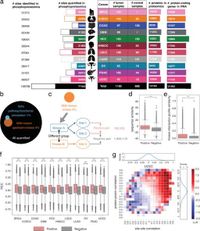In a significant advancement for cancer research, a team of scientists has harnessed machine learning to enhance our understanding of protein phosphorylation—a critical process involved in cellular regulation. This process, especially significant in cancer, is the subject of a new study that introduces innovative tools designed to illuminate uncharted aspects of the phosphoproteome.
Protein phosphorylation is pivotal for regulating numerous cellular activities, including cell growth, differentiation, and apoptosis, making it a vital focus in cancer therapy development. However, researchers have long faced a daunting challenge; less than 5% of the human phosphoproteome has been associated with identified kinases, leading to a phenomenon referred to as the dark phosphoproteome. This limitation hampers the development of effective treatments targeting kinases, an area that has garnered considerable attention given that over 70 kinase inhibitors have been approved for cancer therapy since the turn of the century.
To tackle this issue, scientists from multiple institutions collaborated under the auspices of the National Cancer Institute’s Clinical Proteomic Tumor Analysis Consortium (CPTAC). Through their efforts, they developed two groundbreaking tools: CoPheeMap, which maps co-regulation among phosphosites, and CoPheeKSA, which predicts kinase-substrate associations (KSA). Utilizing a comprehensive dataset consisting of 1195 tumor specimens across 11 cancer types, the researchers successfully constructed the CoPheeMap, unveiling connections among an impressive 26,280 phosphosites.
The innovative methodology integrates machine learning techniques with mass spectrometry-based phosphoproteomic data, allowing for superior prediction accuracy in identifying relationships between kinases and phosphosites. These tools have revealed a staggering 24,015 associations between 9399 phosphosites and 104 serine/threonine kinases. The authors of the article emphasized the significance of their research, stating, "Dysregulated protein phosphorylation, often driven by aberrant kinase activity, is implicated in many diseases, including cancer." By identifying the underlying mechanisms of dysregulation, this study highlights understudied kinases that could represent new therapeutic targets.
The research demonstrates not only the inherent potential of machine learning in analysis but also the need to exploit high-dimensional data derived from large-scale cancer studies. The predictive capabilities of CoPheeKSA were validated through comparisons with experimentally determined kinase-substrate specificity, illustrating the reliability of these computational predictions.
These co-regulation networks provide critical insights, particularly in recognizing signals that may have previously gone unnoticed in the “dark” recesses of cell signaling. For instance, certain predicted kinase-substrate associations link previously unexplored phosphorylation sites to their regulatory kinases, presenting pathways that may be critical for understanding tumor biology.
As a prime example, CoPheeKSA successfully identified several high functional score phosphosites that add a new layer of validation to previously drawn hypotheses in cancer biology. The ability to systematically elucidate phosphosites of interest, the authors assert, represents a turning point in clinical research aimed at combatting malignancies.
Furthermore, the findings cue investigators into the importance of phosphosite co-phosphorylation as it serves as an effective predictor of co-regulation. This implies that closely associated phosphosites often participate in shared biological processes, a notion that can significantly impact therapeutic strategies.
With the tools of CoPheeMap and CoPheeKSA, researchers can gain deeper insights into the intricate networks governing cell function and cancer progression. In doing so, they provide a pathway not only for enhanced understanding but also for identifying potential new targets for therapeutic intervention. The authors write, "These analyses unveil dysregulated signaling processes in human cancer and identify understudied kinases as potential therapeutic targets," portraying a compelling future for phosphoproteomics in medical science.
Through their innovative computational approach, this team has ushered in a new era of cancer research, highlighting the collaborative potential of machine learning and high-throughput data analysis. The study not only emphasizes the importance of uncovering the dark phosphoproteome but also lays the groundwork for future explorations where data-driven findings can translate into meaningful biological insights. As research evolves, the hope is to refine these predictions further and explore the complex relationship between kinases and their substrates, ultimately unlocking therapeutic avenues that can enhance patient outcomes in the battle against cancer.




